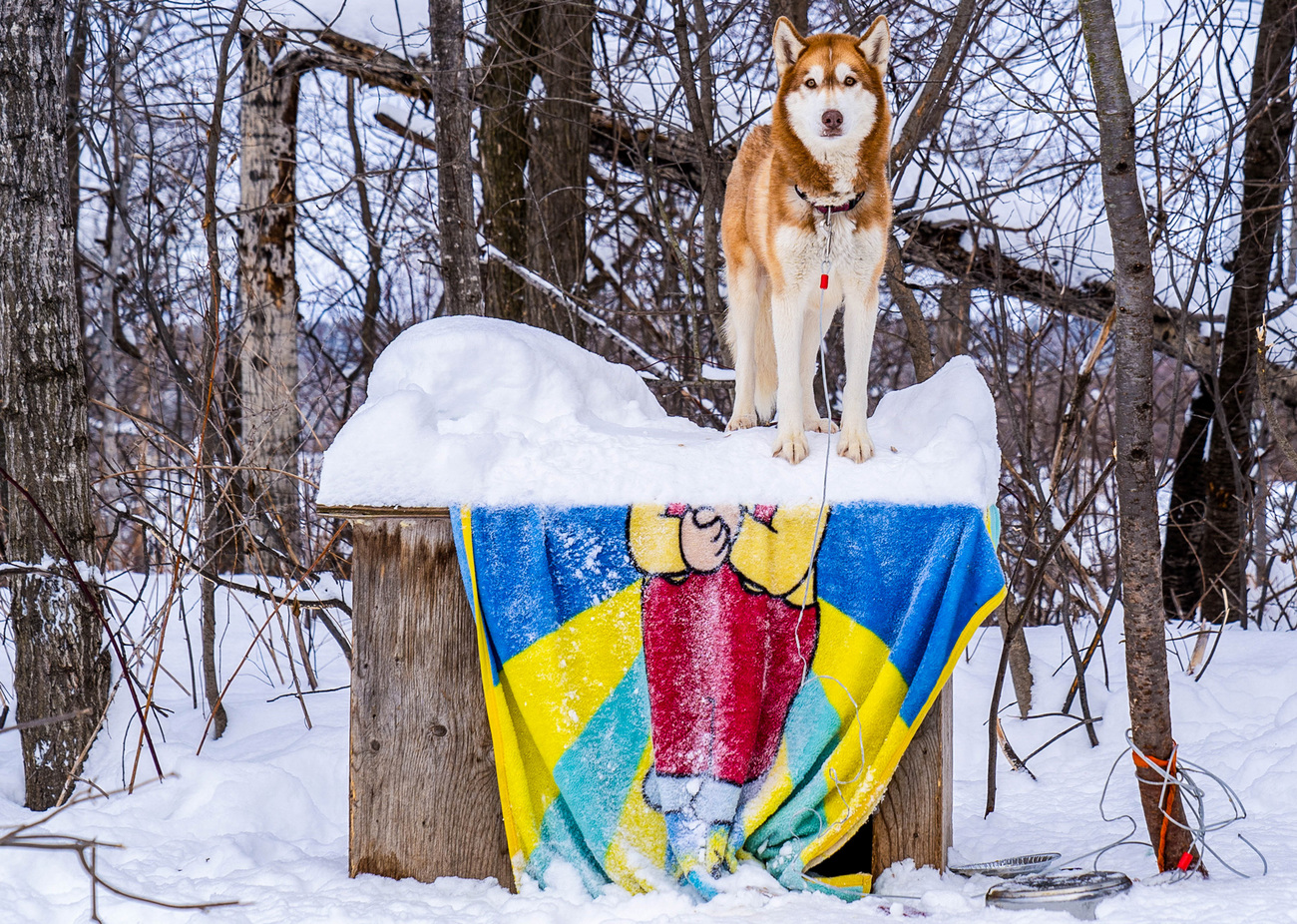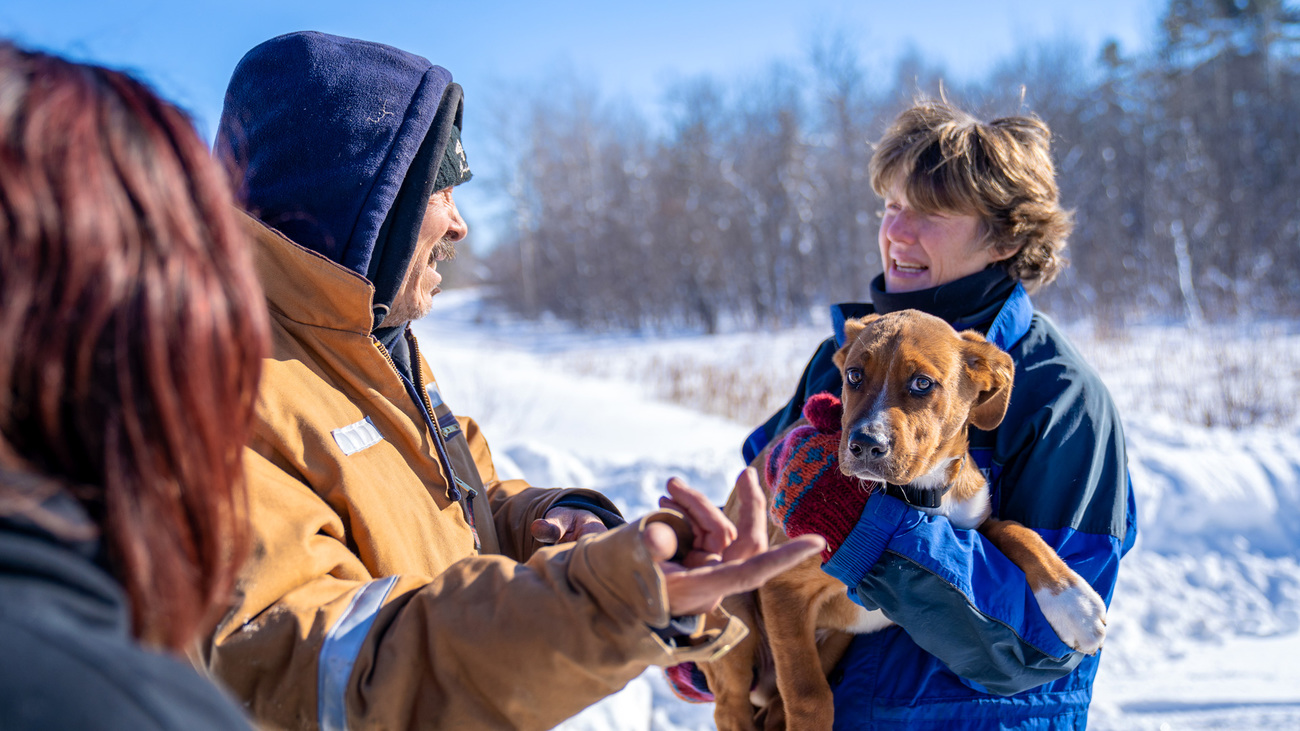Northern Dogs Project - Canada
Distance can’t get in the way of safeguarding dogsHelping to restore the canine connection
Helping to restore the canine connection

A shared history and a divided present
Dogs and Canada’s First Nations peoples share a rich and deep history. Back when people lived on the land, dogs were respected work partners and family members who provided transportation, protection, and companionship. But when people were forced off of their traditional lands, life changed dramatically for them and their dogs. Living in more densely populated communities and with the advent of snowmobiles and work machines, dogs lost their jobs and subsequently their roles in society and the family. Dogs were left to roam—breeding unchecked, scavenging, and gathering in packs. People threw rocks and yelled at them out of fear. Distrust grew between humans and dogs. The dogs that didn’t roam were tied up outside with no shelter, and their basic needs went unmet.
This was not an issue that would be solved by a few spay and neuter clinics. Roaming dogs, unwanted litters, and neglect of care were symptoms of a deeper issue. The connection between these two historically intertwined species had changed.
Working together
The mission of our Northern Dogs Project is to provide support to the First Nations communities as they redefine and rebuild their connection with canines. With the health and safety of both humans and dogs as a priority, we work with them to find a path forward within this new dynamic while honouring their past and respecting their present.
For more than two decades, we have been visiting these communities with our small vet team to hold annual veterinary clinics. The communities are typically located 8-12 hours from the nearest veterinary hospital, making access to veterinary care both geographically and financially impossible. For many of the dogs here, these clinics provide the only professional veterinary services they will ever receive.
These clinics are just one part of the support we provide. Every community has their own set of needs. We build insulated dog houses for families who cannot buy or build them on their own. We fly out and re-home dogs who cannot find homes within the communities. We answer calls and texts from community members with dogs in crisis. We work with Bands to write dog bylaws. We support and advise new animal care officers, sharing resources to further their important work. We created Living in a Good Way with Dogs, a humane education curriculum based on stories from First Nations elders and role models to teach children about their heritage with dogs, how to properly care for them, and how to treat them with kindness and respect. We meet communities where they are, and together, we blaze the trail ahead .

Rebuilding from within
As with all of IFAW’s conservation and rescue programs, we aid and support until a species—or in this case two species living together—can thrive on their own. As the years pass and one community requires less support, we can direct our attention on other communities in need.
Knowledge keepers, role models, and elders are instrumental in building a strong connection between people and dogs. Communities who are able to hire a community-based, year-round animal care officer have seen the greatest improvement in animal welfare and community engagement. Where IFAW used to vaccinate 250 dogs a year, many communities now have a community vaccinator to keep the dogs up to date. And with our annual spay and neuter surgeries, there are fewer litters born, so fewer dogs need surgeries in the following years. But unless veterinary practices can prove profitable in these remote areas, medical care in these communities will always remain scarce.
This year alone, our clinics served 170 animals across three communities, and we provided shelter to outdoor-living dogs by constructing dog houses for them. IFAW’s online course Managing Dogs in First Nations teaches others how to implement real and lasting dog management programmes with their community partners. Fifty-seven individuals, including veterinarians, nurses, animal welfare and shelter staff, and First Nations community members have taken part in the nine-week course, extending the reach of our support to even more communities.
Actions speak louder than numbers
But to accurately measure the impact of IFAW’s work, we need to look beyond the numbers and to the actions.
During our last clinic, when we returned a dog to his home after being neutered, we found a litter of puppies too cold to nurse. We took them back to the clinic, rubbed them warm, and fed them via syringe. A mother dog recovering from her spay surgery in the clinic was still lactating and acted as surrogate when the pups were warm enough to latch on.
But at the end of the day, we had to pack up and move onto the next community. The puppies couldn’t travel with us, and they needed to be bottle fed every few hours. We shared the puppies’ story with a woman who was picking up her dog after surgery, and with no hesitation at all, she said, ‘ I can do that.’
We made sure she understood that bottle feeding was difficult and tedious. The retired grandmother replied, ‘All I have is time.’
She took the pups home, bottle fed them until they were old enough to eat on their own, cared for them, raised them, and found them homes.
I could share a million little stories like this; every year there are more. And each one is a building block to a stronger bond between the community and the dogs within their boundaries, evidence that the support we provide these communities is making a tremendous difference in the lives of both dogs and people.

Change takes time
IFAW works around the world to help communities transform their relationships with animals from conflict to peaceful coexistence. We know it’s a long process, but we never give up. For the people and dogs of northern Canada, their journey goes beyond coexistence to re-establishing the deep bond these two species once shared.
It's a long road ahead, but I have hope. Each time I visit, I see change in the communities. With every passing year, those on the ground need less of my advice and fewer consultations. As one community is able to take on more responsibilities and we slowly decrease our role, we are able to spend more time with others.
There are more than 630 First Nations communities across Canada. The Northern Dogs Project started with eight, and we served three this past year. We want to be there for every community who needs support as they rebuild this ancient bond in the modern world. IFAW is committed to being by their side for as long as it takes, because we know that with the right tools and resources, First Nations peoples and their dogs can thrive together again as they once had, many ages ago.
Related content
Blog
this National Day for Truth and Reconciliation, community continues to be critical for our Northern Dogs Project
read moreBlog
despite new COVID-19 challenges, ifaw's Northern Dogs Project continues to help dogs and Indigenous communities
read moreJames Bay community works to get handle on large, free-roaming dog population
Read moreEvery problem has a solution, every solution needs support.
The problems we face are urgent, complicated, and resistant to change. Real solutions demand creativity, hard work, and involvement from people like you.